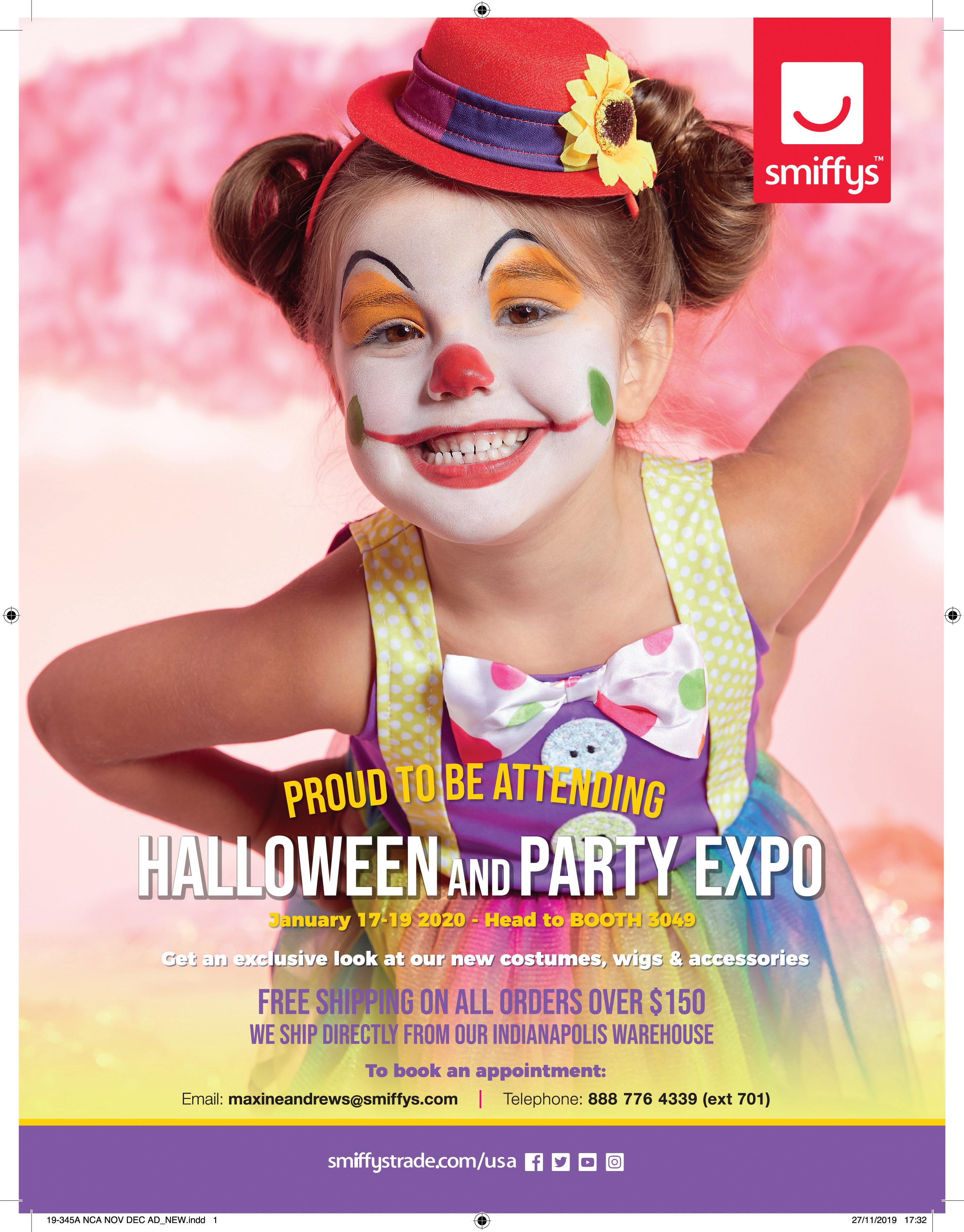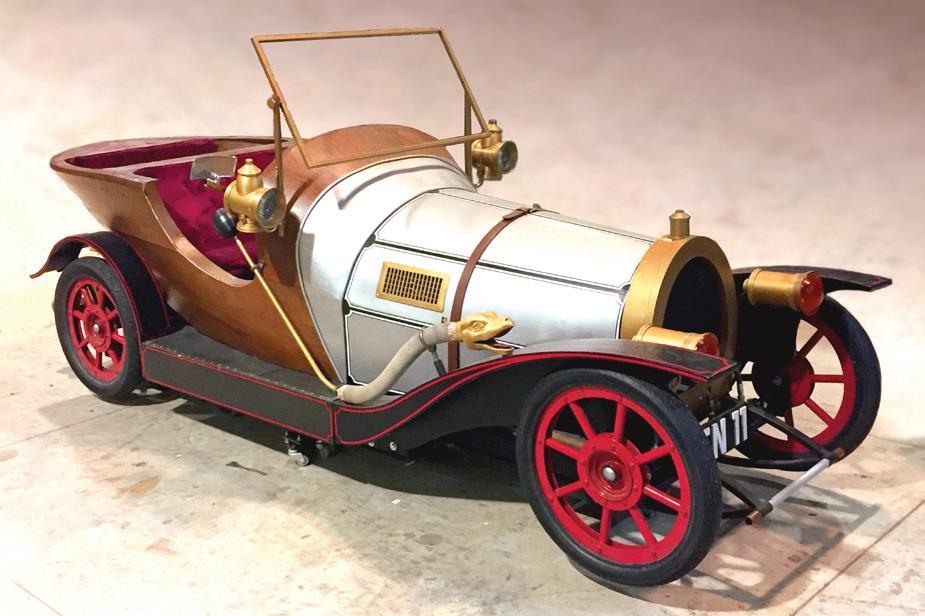
10 minute read
Masks...Unmasked! Opportunities in an Overlooked Category
Masks Unmasked Opportunities abound in an overlooked category

By Kathleen Furore
Another Halloween is in the books and the Christmas season is coming to an end. What are some ways to march into the new year armed with ideas to perk up sales? Don’t overlook masks!
While you might think of creative face covers as predominantly Halloween items, masks can boost your bottom line all year, according to Kyra Stewart, owner of A Masquerade Costume in Redmond, Washington— an NCA-member shop that specializes in masquerade art masks.
“After Halloween, chronologically, comes ‘Masquerade Season,’ which lasts approximately through Mardi Gras,” Stewart explains. “In the United States, masquerade balls are popular and common as celebrations for New Year’s Eve. Ironically, in the United States, we also find secular celebrations of masquerade during the 40 days following Carnevale/Mardi Gras. You would not find this in Italy, but masquerade season extends a little longer in the United States. Masquerade wedding receptions have also been gaining popularity over the last decade. When my customers are looking for more places to wear their masks, I let them know that I will always
post on my Facebook page about any public parties and celebrations all year round.”
How did Stewart decide to make masks such a big part of her business? And what advice does she offer other costumers interested in expanding the category? The Costumer: Masquerade Costume carries a much wider selection of masks than most other costume shops. How did you get into specializing in the mask category? Stewart: When I started a costume rental business in 1999 from a private collection of costumes, I also had 10 handmade art masks from Italy that I offered for rent. The masks depicted commedia dell’arte characters, archetypes, from which all comedy blossoms. Commedia dell’arte masks date back to the Renaissance but have been in continual use up until modern times for two primary purposes: character identification in physical theater, and anonymity during the carnival season, just before Lent (aka Mardi Gras). To me, masks are a basic foundation of theater and celebration, and my business serves both purposes.
The collection has grown over the years, and the selection changes, as customers acquire the inventory, and as I meet new mask artists. Twenty years since I began offering my collection to the public, I now typically have around 500 masks in stock at any given time.
I like to support local artists as well as artists who are maintaining mask-making traditions in Brazil and Italy and other places around the globe.
The masks are displayed prominently in the store and well-lit, as a museum of handmade wearable art. When people are browsing, I let them in on the secret—that a mask chooses you, rather than you choosing a mask. The art speaks to our alter egos, a reflection.

Marketing w ith Masks
Interested in boosting business with masks? Try offering workshops and classes for adults and kids alike. *Sponsor a kids’ mask-making workshop on weekends and/ or during school breaks at a local library or school. One great idea “borrowed” from the 2016 Boston Book Festival event “Hubbub: Creative Commotion for Kids” is to have young artists make an imaginary self by crafting a mask they can embellish with paint, stickers, feathers and other art supplies. At the Boston event, kids then wrote a story, scene or poem starring their “persona.” *Offer a mask-making class for adults. Renowned mask maker Jeff Semmerling of Art Side Out Studio & Mask Shop offers beginning, intermediate and advanced mask making classes in his Chicago studio. But you don’t have to be an expert mask maker to give adults the chance to be creative. *Don’t forget weddings and proms! Create a display or flyers that feature mask ideas for wedding and prom season and post them on your Facebook and Instagram accounts. A pinterest search will turn up myriad ideas you can share!
The Costumer: Do you offer any kind of mask-making classes or other events to help promote masks? Stewart: One of the artists whose work we feature goes by the name FaceOdd. It’s a play on the word facade. She works with beef industry by-product leather, incorporating natural flaws of the hides into her designs. And she regularly schedules workshops for people to learn how to make their own leather art masks. We promote her classes and workshops through our store.
Whenever we hear about a masquerade event or class, usually from someone shopping in our store or from one of our artists, we like to pass the word and use our Facebook business page as the way to get people excited about mask wearing, and mask making, opportunities. The Costumer: What advice would you have for independent costume shop owners who are looking to add or expand the mask category? Stewart:Choose masks that complement the rest of your collection. Be ready to show customers what they can wear with that mask, including your wigs, headwear, cloaks, formal wear, period costumes, exciting footwear, etc. There are no hard rules for masquerade, so help them play with mashups of history and find their radical self-expression. Make the mask seem like the central part of a complete head-to-toe look. Everything else in your store is what goes with those masks!

2020 Here We Come! NCA Survey Shows Worries & Hope for Coming Year
By Ed Avis

Meredith Smith-Lane, alternatives to quality rethe theatrical manager tailers. Furthermore, the of Party Productions/ proliferation of cheap Masque Productions in products—and their Fort Dodge, Iowa, has ubiquitous availability— seen her costume sales has cut into the slim slump in the past year. margins retailers earn. With so many costumes “No one was available on Amazon and coming into our store at other mass merchananymore,” says Elizabeth disers, it’s hard for a Visciano, owner of Betsy bricks-and-mortar busiRoss Costumes in Lockness like Party Producport, New York, when tions to compete. asked why she switched
But it’s another story to online sales only. “We when it comes to theatriclosed our store of 35 cal costume rentals. In years in 2017 and moved that market, Smith-Lane everything into a waresees more and more house.” customers. That move has
“I feel that our bread helped because it suband butter is turning from Halloween to theatriElizabeth Visciano (right) of Betsy Ross Costumes says unusual items—often used in steampunk costumes—are selling well. stantially cut Visciano’s overhead costs, but she cal,” she says. “A few years still struggles. She rarely ago, we started a mailing once or twice a year to every high invests in new inventory these days and is slowly selling off school in Iowa. We send it so it’s sitting there on the drama what she has. director’s desk when school starts or after Christmas. We’ve However, there is a bright spot in her business: When she got business from schools all across the state. And their word can locate unusual, quality items, especially those made in the of mouth has generated a lot of others. I’ve had more schools United States, she sells them quickly. this semester than ever before.” “I’m constantly looking for more sources of quality stuff,
Smith-Lane’s experience is fairly typical among costume made-in-America things,” she reports. “For example, we’re into shop owners. According to a survey sent to NCA members the steampunk thing, and it’s nice to find some unusual, rare in early December, 54 percent have seen “worse” or “much things that aren’t everywhere else. When I find those things, worse” costume sales in 2019 compared to 2018. In contrast, they sell quickly.” 64 percent of respondents said their costume rental business is “about the same” or “better” in 2019 than in 2018. Non-Costume Sales The NCA survey also asked about sales of non-costume items, brigh t spot: Quality and the results there were more evenly distributed. The decline in costume sales is not a new trend, of course. When asked about sales of accessories, such as wigs and Many NCA members have suffered from the growth of online makeup, 23 percent of respondents said sales have been “betsales, big box stores, Halloween pop-up shops, and other cheap ter” or “much better” in 2019 versus 2018, and 46 percent said
december 2019 12 costumers.org

Meredith Smith-Lane, Party Productions/Masque Productions those sales are “about the same” as last year.
Sales of items unrelated to apparel, such as balloons and magic tricks, have been mostly flat, according to the survey. Nearly 60 percent of respondents said such sales are “about the

same” as in 2018, while 33 percent report that they are “worse” or “much worse.” Related to that question, an open-ended question asked respondents what other products or services they offer. The responses revealed how creative some NCA members get with their offerings: among the items and services they offer are mascots, stage sound and lighting rentals, seasonal party decorations, scrapbooking supplies, balloons, horror toys and collectibles, sporting goods, custom costumes, and gift items.
Next Year? mixed feelings
Another survey question asked readers how they felt about the coming year. Half of the respondents said they are worried that 2020 will be worse than 2019. The other half were about evenly split between feeling the coming year will be about the same as 2019 and confident that the new year will be better.
Smith-Lane embodies that split feeling. On the one hand, Party Productions/Masque Productions now has a full-time seamstress to support their growing theatrical business; on the other hand, Smith-Lane is not ordering more bagged costumes.
There always will be different opinions on issues impacting your business, of course. But one thing remains constant: As an NCA member, you can seek advice from fellow members and staff alike on any topic, including how to make your business grow and evolve in the ever-changing world of costuming.
Ed Avis is the publisher of The Costumer magazine.


LACIS Museum of Lace and Textiles: A fashion resource in Berkeley, California By Kathleen Furore

If you’re interested in learning about the history of lace and textiles, the LACIS Museum of Lace and Textiles (LMLT) in Berkeley, California should be on your short-list of places to visit.
Established in October 2004, LMLT is the legacy of Kaethe Kliot, who has been described as “the spirit of the Lacis Textile Center and Retail Store, a haven for the textile community and all involved in virtually every aspect of the textile arts.”
As the museum’s website notes, “This spirit remains, after her untimely passing in 2002, in the museum, which encompasses all that she loved.”
ALook Insid e
The museum’s goal is three-fold: to preserve the spirit of Lacis by establishing a place of support, knowledge and encouragement for all involved in any aspect of the textile arts; to preserve lace and textiles of all cultures from all periods, including the patterns and tools of creation, the objects of their purpose and the literature associated with these objects; and to provide a resource center for research and documentation of these objects.
What can you expect to find when you visit?
Jules and Kaethe Kliot’s lace and textile collection, which represents 40 years of dedication to the preservation of the finest of human handiwork, is the central collection housed at LMLT. It includes thousands of specimens ranging from items from pre-Columbian Peru to the finest laces from the 17th century European courts to examples of the machine laces that exemplify the 19th century Industrial Revolution.



